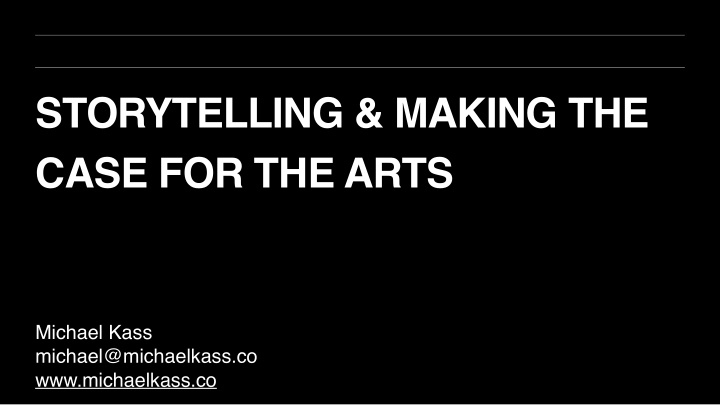



STORYTELLING & MAKING THE CASE FOR THE ARTS Michael Kass michael@michaelkass.co www.michaelkass.co
AGENDA 2 ‣ (re)Defining Story ‣ Characteristics of Strong Stories ‣ Building Your Story ‣ Discovering Their Story ‣ Q&A ‣ Wrap Up
STORYTELLING FOR BUSINESS DEVELOPMENT 3 DEFINING STORY
REDEFINING STORY 4 WHAT IS STORY?
REDEFINING STORY 5 STORY IS THE BASIC BUILDING BLOCK OF COMMUNITY
REDEFINING STORY 6 WE ARE WIRED FOR STORY Example Person 1 Where’s John? Person 2 Well. . .I didn’t want to say anything, but the baseball bat is missing and I saw a blue Prius parked in front of Megan’s.
REDEFINING STORY 7 WE ARE WIRED FOR STORY ‣ We filter information through a Neural Story Net Example A group of anti-vaccine parents attended a meeting in at which all the evidence supporting the safety and necessity of vaccination was presented. . .
REDEFINING STORY 8 WE ARE WIRED FOR STORY ‣ Neural Coupling ‣ Storytelling is mind control! ‣ Chemical and hormone release ‣ Stories promote empathy!
9 WHAT MAKES A STRONG STORY?
10 WHAT MAKES A STRONG STORY? How did you What stood What did What did What confront this in your you learn? you want? happened? challenge? way? Pro-tip 1: Pro-tip 2: Pro-tip 3: Use senses Show is and details to Listen as you stronger than help bring the speak. tell. story to life.
WHAT MAKES A STRONG STORY 11 STRUCTURE √
WHAT MAKES A STRONG STORY? 12 SPECIFICITY ‣ Details allow us to live in the story AND every detail comes with a price ‣ Beware of ‘flood-lighting’ ‣ Experiment with different senses
WHAT MAKES A STRONG STORY? 13 AUTHENTICITY ‣ Stories match actions ‣ Appeals to universal humanity ‣ Vulnerability NOTE: Authenticity and vulnerability are not the same as full- disclosure or over- sharing!
WHAT MAKES A STRONG STORY? 14 CALL TO ACTION SPECIFIC ACTIONABLE MEANINGFUL
STORYTELLING FOR BUSINESS DEVELOPMENT 15 BUILDING POWERFUL STORIES
1. GENERATE RAW MATERIAL 16 1. Story Files 2. Peaks and Valleys 3. Origin, Transformation, Growth
1.5 GENERATE RAW MATERIAL 17 The Six Story Types Who Am I What Am I Doing Here My Vision Values In Action ‘I Know What You’re Thinking’ A Teaching Story **adapted from The Story Factor by Annette Simmons
2. KNOW YOUR AUDIENCE 18 1. Who is your audience demographically? Politically? 2. How much do they know about you and your work? 3. What is their relationship to you and your work? 4. What are they passionate about? 5. What communities are they a part of?
3. YOUR CALL TO ACTION 19 Review your call to action to ensure that it is: ‣ Specific ‣ Meaningful ‣ Actionable
4. PUT IT ALL TOGETHER 20
21 UNCOVERING THEIR STORY
22 5. WHAT’S THEIR STORY? The Delta Model 1. Where are you right now? 2. Where do you want to be? 3. What is standing in the way of you getting from where you are to where you want to be?
THANK YOU & KEEP IN TOUCH WWW.MICHAELKASS.CO MICHAEL@MICHAELKASS.CO @MICHAEL_KASS
Recommend
More recommend